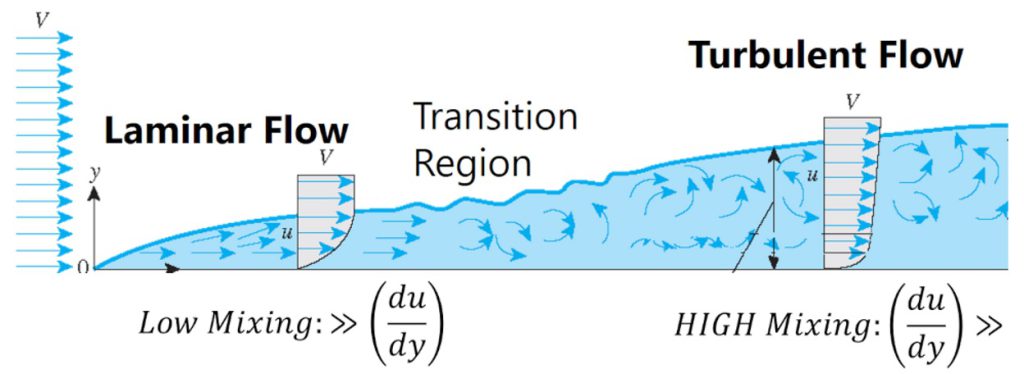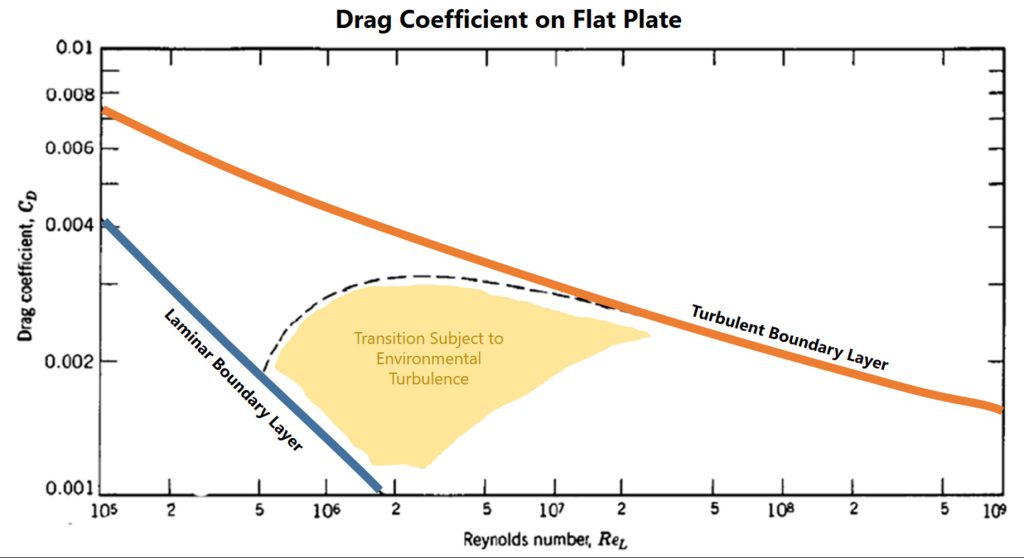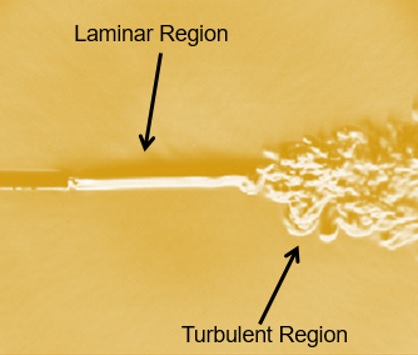The boundary layer is a thin region of fluid that encapsulates the body; the effect of friction is dominant in this region due to surface contact with the body. This contact poses a skin friction force that acts tangent to the surface of the body. Flow outside the bound layer is dominated by the effect of pressure distribution, but physical interaction of the fluid happens in the boundary layer. Therefore, aerodynamic The study of the boundary layer has been one of the most important topics in aerodynamics.
What is Boundary Layer
The viscosity of a fluid defines its tendency to exert a shear force between the two layers of the fluid; however, a fluid moving at a uniform speed does not have an internal shear force due to the zero gradient of axial speed in the direction normal to the direction of flow. The fluid element at the surface of the body is essential at zero velocity (also called “No Slip condition”), hence forcing a speed gradient in the direction normal to fluid motion (denoted as the local y-axis). Hence, skin friction at the surface of the body is given by Newton’s shear stress law, as given below:

The aerodynamic drag of the bodies comprises both pressure drag (due to pressure distribution) and skin friction drag. In fact, in some cases, skin friction drag tends to dominate pressure drag, such as during high-speed flights of airlines. Therefore, it is needless to say that reducing skin friction is essential for low fuel consumption, hence the reduced carbon emissions.
Laminar vs Turbulent Flow
Skin friction is proportional to the velocity gradient in the boundary layer, and the velocity gradient increases as flow develops across the surface of the body due to mixing of the disturbed flow, also called turbulent flow. Turbulent flow exhibits strong mixing, resulting in more friction compared to its counterpart laminar flow (this reference has provided a good explanation of a turbulent flow) . Laminar flow does not have an abrupt variation of velocity gradient in the vertical direction and has smooth, undisturbed characteristics. Laminar flow definitely offers low skin friction and is more desirable, but flow in boundary layers transitions from laminar to turbulent due to the internal friction of fluid layers or simply viscosity.

Viscosity has a crucial impact on the laminar-to-turbulent flow transition. The transition of the boundary layer from smooth laminar to turbulent flow is characterized by Reynold’s Number Re which is defined as the ratio of inertial force (momentum of fluid) to viscous force (viscosity of fluid), as given below:

Transition Re can vary in a band of uncertainty due to the other influencing parameters such as surface roughness, inherited turbulence in flow, upcoming pressure gradient, and even the heat transfer with the body surface. Given below is the chart describing the skin friction coefficient and transition Re for flat plate. It is evident from the graph that skin friction drag is 2.0~2.5 times higher in a turbulent flow compared to laminar flow.

Nature Favors Turbulent Flow
A turbulent boundary layer condition has more skin friction due to the strong mixing of fluid layers, but this mixing causes more momentum transfer from the outer or free-stream flow. This extra momentum helps turbulent flows overcome the incoming pressure gradient, such as the adverse pressure gradient behind a sphere or the flow near the trailing edge of an airfoil. Therefore, turbulent flow helps delay the flow separation.

Conditions Favors Laminar Flow
Laminar flow is the most favorable condition to occur on aerodynamic bodies to reduce the skin friction drag since the adverse pressure gradient is already managed by streamlining the body shape. In fact, for airliners, skin friction contributes a major portion of the high-speed drag (up to 50%).
Impact on Drag
As we already discussed, skin friction drag occurs due to internal friction of the fluid imposed by the no slip condition at the surface of an object; otherwise, a uniform fluid velocity does not impose shear stress. Hence, skin friction extracts the momentum from the free-stream, resulting in the skin friction drag. From a conservation point of view, the momentum of the fluid in free-stream shall remain constant; hence, the difference in the momentum forward and aft of the body is equal to the drag force. In the absence of pressure drag (see article on “Adverse Pressure Gradient“), skin friction is the only contribution to the drag force. Flow conditions in the boundary layer also effect the flow separation and wake formation. A turbulent boundary layer tends to delay flow separation due to its higher energy compared to laminar flow.

Laminar flow condition seem more favorable as it offers minimal friction in the fluid. However, turbulent flow condition is suitable for flows that are subjected to strong adverse pressure gradients; such as flow behind the spherical objects and airfoils at high angle of attack. In fact a laminar flow condition is harder to maintain as various parameters in nature favor entropy; therefore, natural flows tend to be turbulent.

